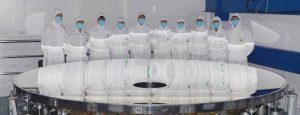It is was by sintering SiC powder, starting with 12 segments in their ‘green’ state.
These were stuck together using a bonding agent made from a mixture of SiC powder and phenolic resin, carefully designed in grain size and composition to blend in with the segments as the whole thing was baked into one solid structure during the final sintering step.
The result was a single mirror blank with almost homogeneous properties.
Telescope mirrors need to resist deformation under their own weight, which is why stiff light materials like silicon carbide are chosen – this particular one weights around 120kg/m2.
To cover pores in the front surface of the sintered structure, a smooth layer of silicon 12μm thick was deposited using a physical vapour deposition process developed to keep temperature, and therefore distortion, to a minimum.
After final processing, surface roughness and surface shape errors are a few nanometres.
If you like optical discussions, or some construction detail, the paper ‘Challenges and strategies in high-accuracy manufacturing of the world’s largest SiC aspheric mirror’ describes the project clearly in Light: Science & Applications

